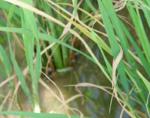What it does
Copper deficiency affects the metabolic processes of rice plants, specifically photosynthesis and respiration. It can lead to reduced pollen viability and increase in spikelet sterility, thus developing many unfilled grains.
Why and where it occurs
Cu deficiency is relatively rare especially in irrigated rice systems. It can occur on the following soil types:
- High organic matter status soils (Histosols, humic volcanic ash soils)
- Lateritic,highly weathered soils (Ultisols, Oxisols)
- Soils derived from marine sediments (limestone)
- Sandy textured soils
- Calcareous soils
How to identify
Check the leaves for the following symptoms:
- chlorotic streaks on either side of the midrib
- dark brown necrotic lesions on leaf tips
- bluish green and chlorotic near the leaf tip
- rolling of new leaves
New leaves do not unroll and the upper portion of leaves have a needlelike appearance, while the lower portion of the leaf appears normal
Plants also have reduced tillering.
When affected, pollen viability is reduced; this means, spikelets become sterile and develop unfilled grains.
To confirm Cu deficiency, bring soil and plant sample to a laboratory for testing.
Click on images to enlarge
How to manage
There is currently no practical field management options for copper deficiency.
Learn more
View full fact sheet:
Copper deficiency on IRRI Rice Knowledge Bank


